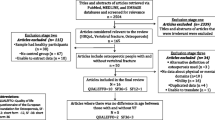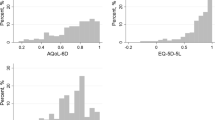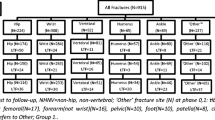Abstract
Summary
We assessed the health state utility value (HSUV) reductions associated with vertebral fractures using data collected in the Japanese Osteoporosis Intervention Trial-03 (JOINT-03). Our analysis revealed that assessment of HSUVs after morphometric vertebral fracture is important to capture the burden of vertebral fractures.
Introduction
Evaluation of the HSUV after fracture is important to calculate the quality-adjusted life years (QALYs) of osteoporosis patients, which is essential information in the context of health economic evaluation.
Methods
JOINT-03 study patients were aged ≥65 years and treated with risedronate and vitamin K2 or risedronate alone. Radiographic information and patient-reported outcomes measured by EQ-5D and a visual analogue scale (VAS) were assessed at registration and followed up after 6, 12, and 24 months. According to differences among the dates of these assessments and the radiographic information, we classified the follow-up HSUVs calculated based on EQ-5D results into before or after fracture categories regardless of clinical symptoms.
Results
Among 2922 follow-up HSUVs, 201 HSUVs were categorized as HSUVs that were observed after incident vertebral fractures on X-ray films. The median time from the detection of an incident vertebral fracture until the EQ-5D assessment was 53 days (25th percentile, 0 day; 75th percentile, 357 days). The impact of incident vertebral fractures on HSUVs was quantified as −0.03. Among the five health profile domains on the EQ-5D, an incident vertebral fracture had significant effects on anxiety/depression, self-care, and usual activities.
Conclusions
The results suggest that incident morphometric vertebral fracture was associated with impairment of the HSUV for patients with osteoporosis not only immediately but also several months after the fracture.


Similar content being viewed by others
References
Mithal A, Ebeling P, Kyer CS (2013) Asia-Pacific Regional Audit: epidemiology, costs & burden of osteoporosis in 2013. International Osteoporosis Foundation, Nyon
Tosteson ANA, Melton LJ III, Dawson-Hughes B, Baim S, Favus MJ, Khosla S, Lindsay RL (2008) Cost-effective osteoporosis treatment thresholds: the United States perspective. Osteoporos Int 19:437–447
Stevenson MD, Selby PL (2014) Modelling the cost effectiveness of interventions for osteoporosis: issues to consider. PharmacoEconomics 32:735–743
Guyatt GH, Feeny DH, Patrick DL (1993) Measuring health-related quality of life. Ann Intern Med 118:622–629
Tosteson ANA, Hammond CS (2002) Quality-of-life assessment in osteoporosis: health-status and preference-based measures. PharmacoEconomics 20:289–303
Lips P, van Schoor N (2005) Quality of life in patients with osteoporosis. Osteoporos Int 16(5):447–455
Tosteson ANA, Gabriel SE, Grove MR, Moncur MM, Kneeland TS, Melton LJ III (2001) Impact of hip and vertebral fractures on quality-adjusted life years. Osteoporos Int 12:1042–1049
Jonsson B, Strom O, Eisman JA, Papaioannou A, Siris ES, Tosteson A, Kanis JA (2011) Cost-effectiveness of denosumab for the treatment of postmenopausal osteoporosis. Osteoporos Int 22:967–982
Silverman S, Agodoa I, Kruse M, Parthan A, Orwoll E (2015) Denosumab for elderly men with osteoporosis: a cost-effectiveness analysis from the US payer perspective. J Osteoporos 2015:627–631
Cummings SR, Melton LJ (2002) Epidemiology and outcomes of osteoporotic fractures. Lancet 359(9319):1761–1767
Silverman SL, Minshall ME, Shen W, Harper KD, Xie S, Health-Related Quality of Life Subgroup of the Multiple Outcomes of Raloxifene Evaluation Study (2001) The relationship of health-related quality of life to prevalent and incident vertebral fractures in postmenopausal women with osteoporosis: results from the Multiple Outcomes of Raloxifene Evaluation Study. Arthritis Rheum 44:2611–2619
Delmas PD, van de Langerijt L, Watts NB, Eastell R, Genant H, Grauer A, Cahall DL (2005) Underdiagnosis of vertebral fractures is a worldwide problem: the IMPACT study. J Bone Miner Res 20:557–563
Borgstrom F, Zethraeus N, Johnell O, Lidgren L, Ponzer S, Svensson O, Abdon P, Ornstein E, Lunsjo K, Thorngren KG, Sernbo I, Rehnberg C, Jonsson B (2006) Costs and quality of life associated with osteoporosis-related fractures in Sweden. Osteoporos Int 17:637–650
Borgstrom F, Lekander I, Ivergard M, Strom O, Svedbom A, Alekna V, Bianchi ML, Clark P, Curiel MD, Dimai HP, Jurisson M, Kallikorm R, Lesnyak O, McCloskey E, Nassonov E, Sanders KM, Silverman S, Tamulaitiene M, Thomas T, Tosteson ANA, Jonsson B, Kanis JA (2013) The international costs and utilities related to osteoporotic fractures study (ICUROS)—quality of life during the first 4 months after fracture. Osteoporos Int 24:811–823
Hagino H, Nakamura T, Fujiwara S, Oeki M, Okano T, Teshima R (2009) Sequential change in quality of life for patients with incident clinical fractures: a prospective study. Osteoporos Int 20:695–702
Hiligsmann M, Ethgen O, Richy F, Reginster JY (2008) Utility values associated with osteoporotic fracture: a systematic review of the literature. Calcif Tissue Int 82:288–292
Peasgood T, Herrmann K, Kanis JA, Brazier JE (2009) An updated systematic review of health state utility values for osteoporosis related conditions. Osteoporos Int 20:853–868
Si L, Winzenberg TM, de Graaff B, Palmer AJ (2014) A systematic review and meta-analysis of utility-based quality of life for osteoporosis-related conditions. Osteoporos Int 25:1987–1997
Cockerill W, Lunt M, Silman AJ, Cooper C, Lips P, Bhalla AK, Cannata JB, Eastell R, Felsenberg D, Gennari C, Johnell O, Kanis JA, Kiss C, Masaryk P, Naves M, Poor G, Raspe H, Reid DM, Reeve J, Stepan J, Todd C, Woolf AD, O'Neill TW (2004) Health-related quality of life and radiographic vertebral fracture. Osteoporos Int 15:113–119
van Schoor NM, Ewing SK, O'Neill TW, Lunt M, Smit JH, Lips P (2008) Impact of prevalent and incident vertebral fractures on utility: results from a patient-based and a population-based sample. Qual Life Res 17(1):159–167
Cooper C, Jakob F, Chinn C, Martin-Mola E, Fardellone P, Adami S, Thalassinos NC, Melo-Gomes J, Torgerson D, Gibson A, Marin F (2008) Fracture incidence and changes in quality of life in women with an inadequate clinical outcome from osteoporosis therapy: the Observational Study of Severe Osteoporosis (OSSO). Osteoporos Int 19:493–501
Cummings SR, San MJ, McClung MR, Siris ES, Eastell R, Reid IR, Delmas P, Zoog HB, Austin M, Wang A, Kutilek S, Adami S, Zanchetta J, Libanati C, Siddhanti S, Christiansen C (2009) Denosumab for prevention of fractures in postmenopausal women with osteoporosis. N Engl J Med 361:756–765
Sugimoto T, Shiraki M, Nakano T, Kishimoto H, Ito M, Fukunaga M, Hagino H, Sone T, Kuroda T, Nakamura T (2013) Vertebral fracture risk after once-weekly teriparatide injections: follow-up study of Teriparatide Once-Weekly Efficacy Research (TOWER) trial. Curr Med Res Opin 29:195–203
Nakamura T, Matsumoto T, Sugimoto T, Hosoi T, Miki T, Gorai I, Yoshikawa H, Tanaka Y, Tanaka S, Sone T, Nakano T, Ito M, Matsui S, Yoneda T, Takami H, Watanabe K, Osakabe T, Shiraki M, Fukunaga M (2014) Fracture risk reduction with denosumab in japanese postmenopausal women and men with osteoporosis: Denosumab fracture Intervention RandomizEd placebo Controlled Trial (DIRECT). J Clin Endocrinol Metab
Nevitt MC, Ettinger B, Black DM, Stone K, Jamal SA, Ensrud K, Segal M, Genant HK, Cummings SR (1998) The association of radiographically detected vertebral fractures with back pain and function: a prospective study. Ann Intern Med 128:793–800
Kanis JA, Johnell O, Oden A, Borgstrom F, Zethraeus N, Laet C, Jonsson B (2004) The risk and burden of vertebral fractures in Sweden. Osteoporos Int 15:20–26
Nuti R, Caffarelli C, Guglielmi G, Gennari L, Gonnelli S (2014) Undiagnosed vertebral fractures influence quality of life in postmenopausal women with reduced ultrasound parameters. Clin Orthop Relat Res 472:2254–2261
Tanaka S, Miyazaki T, Uemura Y, Kuroda T, Miyakawa N, Nakamura T, Fukunaga M, Ohashi Y, Ohta H, Mori S, Hagino H, Hosoi T, Sugimoto T, Itoi E, Orimo H, Shiraki M (2014) Design of a randomized clinical trial of concurrent treatment with vitamin K2 and risedronate compared to risedronate alone in osteoporotic patients: Japanese Osteoporosis Intervention Trial-03 (JOINT-03). J Bone Miner Metab 32:298–304
Orimo H (2007) The Japanese guidelines for the prevention and treatment of osteoporosis (2006 edition). Osteoporos Jpn 15:351–355
Genant HK, Wu CY, van Kuijk C, Nevitt MC (1993) Vertebral fracture assessment using a semiquantitative technique. J Bone Miner Res 8(2):1137–1148
Tsuchiya A, Ikeda S, Ikegami N, Nishimura S, Sakai I, Fukuda T, Hamashima C, Hisashige A, Tamura M (2002) Estimating an EQ-5D population value set: the case of Japan. Health Econ 11:341–353
Ikeda S, Ikegami N (2001) Preference-based measure (EQ-5D). In: Ikegami N, Fukuhara S, Shimozuma K, Ikeda S (eds) QOL evaluation handbook for clinical practice (in Japanese). Igakushoin, Tokyo, pp 14–18
Tanaka S, Miyazaki T, Uemura Y, Miyakawa N, Gorai I, Nakamura T, Fukunaga M, Ohashi Y, Ohta H, Mori S, Hagino H, Hosoi T, Sugimoto T, Itoi E, Orimo H, Shiraki M (2016) Comparison of concurrent treatment with vitamin K2 and risedronate compared to risedronate alone in patients with osteoporosis: Japanese Osteoporosis Intervention Trial-03 (JOINT-03). J Bone Miner Metab (in press)
Gold DT (1996) The clinical impact of vertebral fractures: quality of life in women with osteoporosis. Bone 18(Suppl 3):185S–189S
Williams LJ, Pasco JA, Jackson H, Kiropoulos L, Stuart AL, Jacka FN, Berk M (2016) Depression as a risk factor for fracture in women: a 10 year longitudinal study. J Affective Disorders 192:34–40
Williams LJ, Berk M, Henry MJ, Stuart AL, Brennan SL, Jacka FN, Pasco JA (2014) Depression following fracture in women: a study of age-matched cohorts. BMJ Open 4(2)
Suzuki N, Ogikubo O, Hansson T (2009) The prognosis for pain, disability, activities of daily living and quality of life after an acute osteoporotic vertebral body fracture: its relation to fracture level, type of fracture and grade of fracture deformation. Eur Spine J 18:77–88
Bernert S, Fernandez A, Haro JM, Konig HH, Alonso J, Vilagut G, Sevilla-Dedieu C, de Graaf R, Matschinger H, Heider D, Angermeyer MC (2009) Comparison of different valuation methods for population health status measured by the EQ-5D in three European countries. Value Health 12(5):750–758
Acknowledgments
The authors express thanks to the A-TOP Research Group and those who participated as clinical investigators in the JOINT-03. The JOINT study was sponsored by Public Health Research Foundation. The authors also thank the Japan Arteriosclerosis Prevention Fund; Teijin Pharma Limited; Asahi Kasei Corporation; Takeda Pharmaceutical Company Limited; GE Healthcare Japan; Toyo Medic Co., Ltd.; MSD Co., Ltd.; and Dainippon Sumitomo Pharma Co., Ltd., for their generous donations.
Author information
Authors and Affiliations
Consortia
Corresponding author
Ethics declarations
Conflicts of interest
None
Electronic supplementary material
ESM 1
(DOCX 51 kb)
Appendix. Rules for categorizing patient-reported outcomes
Appendix. Rules for categorizing patient-reported outcomes
Because radiographic assessments were conducted routinely at registration and at intervals of 6, 12, and 24 months in the JOINT-03 study, the date of the assessment did not necessarily correspond to the date of the vertebral fracture. Therefore, judgment of whether the date of the EQ-5D and VAS assessment was before or after the incident vertebral fracture was based on the following rules. If an incident vertebral fracture was detected and the date of EQ-5D and VAS assessments was the same or after the date of the radiographic assessment, all subsequent EQ-5D and VAS outcomes were categorized as outcomes that were obtained after the incident vertebral fracture. If no incident vertebral fracture was detected and the date of the EQ-5D and VAS assessment was the same or before the date of the radiographic assessment, EQ-5D and VAS outcomes were categorized as outcomes that were obtained before an incident vertebral fracture. These were the general procedures in the JOINT-03 study. However, in exceptional cases, the judgment process was not straightforward. For example, when an incident vertebral fracture was detected through radiographic assessment at 12 months, it had actually occurred at some time point between the 6- and 12-month radiographic assessment. In this case, if the EQ-5D and VAS assessment was conducted after the 6-month radiographic assessment but before the 12-month radiographic assessment, it could not be concluded whether the date of the assessment was before or after the incident vertebral fracture. In this situation, judgment was based on the radiographic result that was obtained proximate to the date of EQ-5D and VAS assessments. For example, if an incident vertebral fracture was detected by radiographic assessment and the EQ-5D and VAS assessment had been conducted a few weeks before the radiographic assessment, the EQ-5D and VAS outcomes were judged as having been obtained after the incident vertebral fracture. For the case of incident non-vertebral fracture, the judgment process was simpler because the information on the specific date of the occurrence was available.
Rights and permissions
About this article
Cite this article
Imai, T., Tanaka, S., Kawakami, K. et al. Health state utility values and patient-reported outcomes before and after vertebral and non-vertebral fractures in an osteoporosis clinical trial. Osteoporos Int 28, 1893–1901 (2017). https://doi.org/10.1007/s00198-017-3966-7
Received:
Accepted:
Published:
Issue Date:
DOI: https://doi.org/10.1007/s00198-017-3966-7




